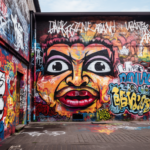In the world of art, few mediums carry the raw, unfiltered voice of the streets quite like graffiti. It’s more than just spray paint on a wall; it’s a dynamic form of expression that has the power to convey messages, provoke thought, and challenge the status quo. Graffiti, when wielded skillfully, becomes a canvas for social and political commentary, sparking conversations that reach far beyond the walls they adorn.
In this exploration of graffiti as a social and political expression, we’ll delve into the origins of this art form, the cultural contexts that have shaped it, and the ways in which graffiti artists have used their talents to shed light on critical issues.
The Roots of Graffiti: A Brief History
Graffiti’s roots can be traced back to ancient civilizations, where it was used to communicate messages, mark territories, and leave behind a historical record. However, the modern graffiti movement, as we know it, began to take shape in the late 20th century in the streets of New York City. It emerged as a form of protest, rebellion, and self-expression among marginalized communities.
Beyond Vandalism: The Evolution of Graffiti
Graffiti was often dismissed as vandalism or a nuisance, but it soon transcended these labels. It became a medium through which artists could reclaim public spaces, challenge authority, and reflect the pulse of society. Artists like Jean-Michel Basquiat and Keith Haring brought graffiti into galleries, blurring the lines between street art and high art.
Graffiti as a Tool for Social Commentary
One of the most compelling aspects of graffiti is its ability to convey powerful social and political messages. Street artists use their work to highlight issues such as inequality, racism, environmental concerns, and government policies. Murals and tags become visual protests, demanding attention and provoking thought.
The Global Impact of Graffiti
Graffiti is not confined to a single location or culture. It has become a global phenomenon, with artists from diverse backgrounds using the medium to address local and global issues. We’ll explore the work of renowned graffiti artists and the impact of their pieces on both local communities and the broader world.
Graffiti’s Role in Community Building
Beyond its role as a form of protest, graffiti has the power to unite communities. Many artists engage in collaborative projects, beautifying neighborhoods, and creating spaces for dialogue. We’ll delve into examples of how graffiti can foster a sense of belonging and pride.
The Challenges and Controversies
While graffiti has its champions, it also faces challenges and controversies. Legal issues, property rights, and debates over aesthetic value persist. We’ll examine these complexities and the ongoing debate over whether graffiti should be celebrated as art or condemned as vandalism.
Looking Ahead: The Future of Graffiti as Social Expression
As we conclude this exploration, we’ll ponder the future of graffiti as a form of social and political expression. How will it continue to evolve in response to changing societal dynamics? What role will it play in shaping our conversations and influencing our perceptions of the world around us?
Join us on this journey through the vibrant, thought-provoking, and ever-evolving world of graffiti as we delve deeper into its roots, impact, and enduring relevance as a powerful form of social and political expression.




